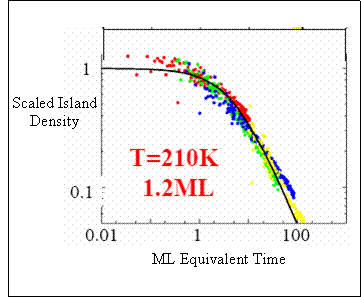
ACS PRF | ACS
All e-Annual Reports

41792-AC10
The Role of Defects and Interfaces in the Growth of Nanocrystals on Surfaces
Introduction: Metals evaporated onto semiconductors provide an excellent laboratory to understand the growth of nanocrystals that can display new and unforeseen phenomena arising from their small size. For Pb deposited on Si substrates it is found that nanocrystals form several monolayers high and several tens of nanometers in diameter. The quantum confinement of electrons is generally believed to be responsible for the appearance of “magic” nanocrystal thicknesses. However, such quantum-size-effect (QSE) arguments imply that the system evolves to its minimum energy state, dictated only by QSE. This seems quite naïve, since, we know that there will be interfacial energies to consider as well as kinetic limitations. Thus, the objective of our project is to examine the interface structure and the growth kinetics in order to develop insight into the physical mechanisms that allow these novel QSE nanocrystals to form.
Interface Studies: We wish to understand the structure of the buried interface between the nanocrystal and the substrate because the interaction of the Pb with the substrate will affect the boundary condition for the electrons that lead to QSE in the nanocrystal as well as the kinetic behavior. However, a highly disordered 1 ML wetting layer, which grows on the Si(111)7x7 substrate before the nanocrystals form, complicates the structural investigation. Our work discovered that when the nanocrystals form on top of the wetting layer, they consume the highly disordered Pb in the wetting layer and convert it into FCC Pb. The way in which this occurs is truly remarkable as it creates a smooth interface between the Pb nanocrystal and the highly corrugated Si(111)7x7 substrate. However, regarding the growth of the nanocrystals, it is important to understand the structure of the wetting layer itself. For example, it is believed that this wetting layer has an excess of Pb which is then transported to the nanocrystals as they nucleate. Our latest in situ x-ray diffraction studies have revealed new structural information about this complex wetting layer. Previously, it was known that the wetting layer followed a 8x8 structure fit within the Si 7x7 surface unit cell. Our measurements have revealed that this structure is modulated both in composition and in displacement. Using a simple 3-wave modulation model, which is consistent with the surface symmetry, we find that the Pb occupancy is a minimum at the corners of the unit cell and that the atoms exhibit maximum displacements towards the center of the cell. The vertical displacements have not yet been determined and future experiments are planned to study this. Density The unanticipated behavior that we observe include: · QSE leads to the breakdown of the Gibbs-Thomson effect that would produce the Ostwald ripening. · The time scale for surface relaxation unexpectedly depends sensitively on the flux rate at which the nanocrystals were originally grown. · The time scale of coarsening is anomalously fast, being 3 orders of magnitude faster than expected from experiments performed on larger crystals. · The relaxation time was found to be inversely proportional to the growth flux rate, which is an entirely unanticipated and, as of yet, an unexplained result. · Because of these unusual properties, surprising kinetic phenomena can occur. For example, the lowest island densities can be created by growing at the highest flux rates. This is opposite to the conventional wisdom in materials synthesis.  Methods: Surface x-ray scattering experiments were performed in situ at the Advanced Photon Source (sector 6) using the in situ UHV surface scattering instrument developed by the PI and Prof. Edward Conrad. X-ray scattering has important advantages for these experiments because of its simultaneous surface and subsurface sensitivity that can be used to explore interfacial structure and morphology. This work was also done in collaboration with Prof. Michael Tringides who performed in situ UHV scanning tunneling microscopy (STM) experiments that yield data that is complementary to the x-ray experiments.
Methods: Surface x-ray scattering experiments were performed in situ at the Advanced Photon Source (sector 6) using the in situ UHV surface scattering instrument developed by the PI and Prof. Edward Conrad. X-ray scattering has important advantages for these experiments because of its simultaneous surface and subsurface sensitivity that can be used to explore interfacial structure and morphology. This work was also done in collaboration with Prof. Michael Tringides who performed in situ UHV scanning tunneling microscopy (STM) experiments that yield data that is complementary to the x-ray experiments.
 Coarsening Kinetics: We have discovered unexpected and novel coarsening kinetics of QSE nanocrystals. Ostwald ripening is the classical mechanism of island coarsening. However, our experiments show that this mechanism does not occur for the very small QSE crystals. Because of the accurate statistical distributions available from x-ray scattering experiments, we have been able to demonstrate novel scaling properties of the distributions that arise. For example, the figure at the right shows that the scaled island density versus a scaled time yields universal behavior. Our results have inspired theoretical groups to develop new models for the coarsening of QSE nanocrystals.
Coarsening Kinetics: We have discovered unexpected and novel coarsening kinetics of QSE nanocrystals. Ostwald ripening is the classical mechanism of island coarsening. However, our experiments show that this mechanism does not occur for the very small QSE crystals. Because of the accurate statistical distributions available from x-ray scattering experiments, we have been able to demonstrate novel scaling properties of the distributions that arise. For example, the figure at the right shows that the scaled island density versus a scaled time yields universal behavior. Our results have inspired theoretical groups to develop new models for the coarsening of QSE nanocrystals.